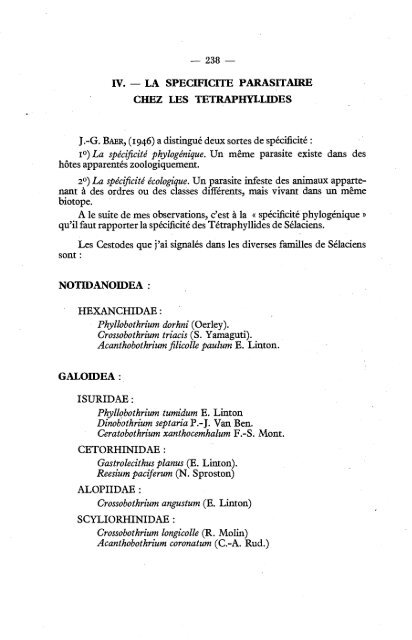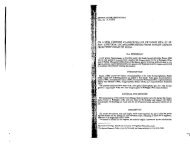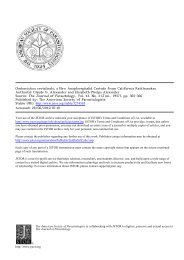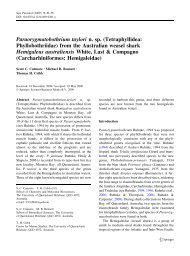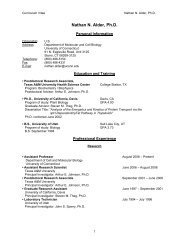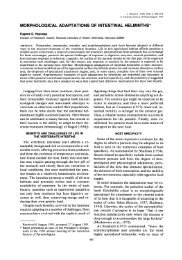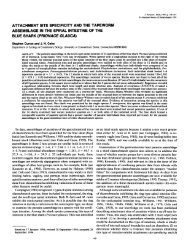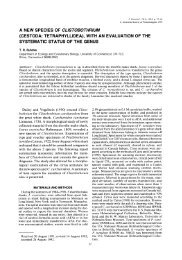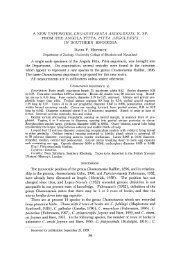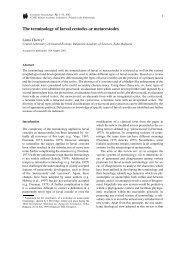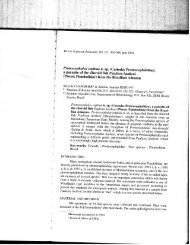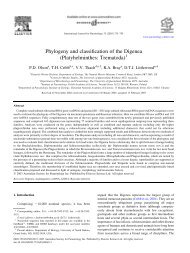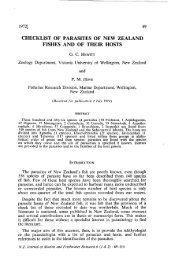- Page 1:
N" D'ORDRE : 140THÈSESPRÉSENTÉES
- Page 5 and 6:
AVANT-PROPOSAu seuil de ce travail,
- Page 7:
INTRODUCTIONLes Cestodes Tetraphyll
- Page 10 and 11:
— 10 —Cette méthode, si elle p
- Page 12 and 13:
— 12 —Crochets. — Comme chez
- Page 14 and 15:
— 14 —La première section se s
- Page 16 and 17:
— 16 —— Echinobothrium P.-J.
- Page 18 and 19:
— 18 —i» PHYLLOBOTHRIIDAE P.-J
- Page 20 and 21:
— 20 —conclu que ce genre pouva
- Page 22 and 23:
— 22 —Une étude attentive du g
- Page 24 and 25:
— 24 —Disposées par paires, le
- Page 26 and 27:
— 26 —J'appelle bord proximal,
- Page 28 and 29:
— 28 —Le nombre des segments va
- Page 30 and 31:
— 30 —Chez Trilocuria acanthiae
- Page 32 and 33:
— 32 —Fig. 10Fig. IIFig. 10.
- Page 34 and 35:
— 34 —La musculature longitudma
- Page 36 and 37:
— 36 —MYZORHYNQUELe myzorhynque
- Page 38 and 39:
— 38 —Comme l'ont déjà signal
- Page 40 and 41:
PHYLLOBOTRIUMLACTUCA P. J. VAN BEN.
- Page 42 and 43:
— 42 —Proglottis de Phyllobothr
- Page 44 and 45:
— 44 —Fig. 23. — Complexe gé
- Page 46 and 47:
— 46 —Fig. 25. — Système gé
- Page 48 and 49:
— 48 —TÉRATOLOGIEChez de nombr
- Page 50 and 51:
— 50 —Sous-famille RHINEBOTHRII
- Page 52 and 53:
— 52 —FamiUè LECANICEPHALIDAE
- Page 54 and 55:
DESCRIPTIONS DES GENRES ET ESPÈCES
- Page 56 and 57:
— 56 —Appareil femelle. — L'o
- Page 58 and 59:
— 58 —ANTHOBOTHRIUM7tLACINIATUM
- Page 60 and 61:
— 60 -SCYPHOPHYLLIDIUM GIGANTEUM
- Page 62 and 63:
iSPHAEROBOTHRIUM LUBETI n. sp.Fig.
- Page 64 and 65:
— 64 —ORYGMATOBOTHRIUM MUSTELI
- Page 66 and 67:
TABLEAU DES ESPÈCES DU GENRE PHYLL
- Page 68 and 69:
— 68 —Z5Û\>PHYLLOBOTHRIUM LACT
- Page 70 and 71:
— 70 —Le cou a de 2 à 3 mm de
- Page 72 and 73:
PHYLLOBOTHRIUM THRIDAX P.-J. Van Be
- Page 74 and 75:
. Fig.58 Fig.59imtnPHYLLOBOTHRIUM D
- Page 76 and 77:
— 76 —PHYLLOBOTHRIUM AURICULA P
- Page 78 and 79:
PHYLLOBOTHRIUM GRACILE K. Wedl, 185
- Page 80 and 81:
— 80 —PHYLLOBOTHRIUM CENTRURUM
- Page 82 and 83:
— 82 —CROSSOBOTHRIUM LONGICOLLE
- Page 84 and 85:
CROSSOBOTHRIUM SQUALI (S. Yamaguti,
- Page 86 and 87:
— 86 —Crossobothrium angustum E
- Page 88 and 89:
— 88 —Le canal utérin, parall
- Page 90 and 91:
— 90 —CALYPTROBOTHRIUM RIGGI F.
- Page 92 and 93:
— 92 —CALYPTROBOTHRIUM OCCIDENT
- Page 94 and 95:
— 94 —Les individus de collecti
- Page 96 and 97:
— 96 —Le canal utérin remonte
- Page 98 and 99:
— 98 —Elles sont surmontées d'
- Page 100 and 101:
— 100 —CLYDONOBOTHRIUM ELEGANTI
- Page 102 and 103:
— 102 —A l'avant le scolex pré
- Page 104 and 105:
TABLEAU DES ESPECES DU GENRE ECHENE
- Page 106 and 107:
— 106 —Le cou est très court (
- Page 108 and 109:
Fig.106Fig.107ECHENEIBOTHRIUM VARIA
- Page 110 and 111:
— 110 —Les proglottis atteignen
- Page 112 and 113:
— 112 —ECHENEIBOTHRIUM DUBIUM P
- Page 114 and 115:
— 114 —Echeneibothrium octorchi
- Page 116 and 117:
— 116 —Le nombre de ses loculis
- Page 118 and 119:
— 118 —L'espèce décrite par N
- Page 120 and 121:
— 120 —Pores sexuels latéraux
- Page 122 and 123:
— 122 —Les vitellogènes sont f
- Page 124 and 125:
— 124 —RHINEBOTHRIUM MINIMUM (P
- Page 126 and 127:
RHINEBOTHRIUM TUMIDULUM (C.-A. Rud.
- Page 128 and 129:
— 128 —bRHINEBOTHRIUM WALGA (A.
- Page 130 and 131:
200,.Fig. 142. — Scolex.Fig. 143.
- Page 132 and 133:
CAULOBOTHRIUM LONGICOLLE (E. Linton
- Page 134 and 135:
RHADOTOBOTHRIUM DOLLFUSI L. Euzet,
- Page 136 and 137:
— 136 —formé de 2 parties : l'
- Page 138 and 139:
— 138 —Le cou a de 1,5 à 2 mm
- Page 140 and 141:
— 140 —Appareil mâle. — Il y
- Page 142 and 143:
TABLEAU DES ESPÈCES DU GENRE ACANT
- Page 144 and 145:
ACANTHOBOTHRIUM CORONATUM (C.-A. Ru
- Page 146 and 147:
— 146 —ACANTHOBOTHRIUM RAJAE BA
- Page 148 and 149:
— 148 —Champ post-vagmal 20—
- Page 150 and 151:
— 150 —ACANTHOBOTHRIUM ZSCHOKKE
- Page 152 and 153:
— .152 -ACANTHOBOTHRIUM DUJARDINI
- Page 154 and 155:
— 154 —Le pédoncule du scolex
- Page 156 and 157:
— 156 —Appareil mâle. — Il y
- Page 158 and 159:
— 158 —Css trois espèces paras
- Page 160 and 161:
— 160 —Appareil mâle. — Il y
- Page 162 and 163:
53 113 lOI156Le nombre de testicule
- Page 164 and 165:
— 164 —CALLIOBOTHRIUM VERTICILL
- Page 166 and 167:
— 166 —-150^1CALLIOBOTHRIUM LEU
- Page 168 and 169:
— 168 —CALLIOBOTHRIUM ESCHRICHT
- Page 170 and 171:
— 170 —à 2 mm de long (fig. 19
- Page 172 and 173:
— 172Ils sont groupés au centre
- Page 174 and 175:
Fig. 201Ut Fig. 203PROSOBOTHRIUM AR
- Page 176 and 177:
— 176 —Le cou et le strobile so
- Page 178 and 179:
— 178 —Les épines cuticulaires
- Page 180 and 181:
— 180 —FamiUe PHOREIOBOTHRIIDAE
- Page 182 and 183:
— 182 —Le plateau musculaire fo
- Page 184 and 185:
PHOREIOBOTHRIUM EXCEPTUM E. Linton,
- Page 186 and 187:
Fig. 22!REESIUM PACIFERUM (N.-G. Sp
- Page 188 and 189: — 188 —TRILOCULARIA ACANTHIAE V
- Page 190 and 191: — 190 -Le scolex mesure de 6,5 à
- Page 192 and 193: — 192 -Strobile presque cylindriq
- Page 194 and 195: — 194Appareil femelle. — L'atri
- Page 197 and 198: CHAPITRE IVBIOLOGIEI. — LES TETRA
- Page 199 and 200: — 199 —Ch. JOYEUX et J.-G. BAER
- Page 201 and 202: — 201 —ToRPEDO NOBILIANA Ch.-L.
- Page 203 and 204: — 203 —SÉLACIENS EXAMINÉS A A
- Page 205 and 206: — 205 —Chez Torpédo marmorata
- Page 207 and 208: — 207 —Ainsi, le Dr. GASTAUD vi
- Page 209 and 210: — 209 —entourant le ver au-del
- Page 211 and 212: — 211 —Il n'en est plus de mêm
- Page 213 and 214: — 2Vi —— Calliobothrium eschr
- Page 215 and 216: — 215 —On constate que la répa
- Page 217 and 218: — 217 —les proglottis de Callio
- Page 219 and 220: — 219 —J'ai ainsi réalisé deu
- Page 221 and 222: — 221 —m. — CYCLES EVOLUTIFS.
- Page 223 and 224: — 223 —Tous les œufs de Tétra
- Page 225 and 226: — 225 —Dès le deuxième jour,
- Page 227 and 228: — 227 —PHYLLOBOTHRIUM LACTUCA P
- Page 229 and 230: — 229 —Fig. 252.SCOLEX PLEURONE
- Page 231 and 232: — 231 —I — — 10 —I —
- Page 233 and 234: — 233 —3 Gobius restants ont r
- Page 235 and 236: — 235 —I Scyliorhinus examiné
- Page 237: — 237 —Cette expérience prouve
- Page 241 and 242: — 241 —Peu de TétraphylHdes se
- Page 243: — 243 —Ceci semble plus éviden
- Page 246 and 247: — 246 —Les œufs pondus isolém
- Page 248 and 249: — 248 —Ces relations entre les
- Page 250 and 251: — 250 —En faisant absorber des
- Page 252 and 253: Orygnatobothrium musteli (P.-J. Van
- Page 254 and 255: — 254RAJA MARGINATA (B.-G. Lacép
- Page 256 and 257: — 256 —BRAUN (Max.), 1900. —
- Page 258 and 259: — 258 —JOHNSTON (T.-H.), 1937.
- Page 260 and 261: — 260 —MONTICELLI (F.-S.)J 1888
- Page 262 and 263: — 262 —SOUTHWELL (T.), 1927.
- Page 265 and 266: TABLE DES MATIÈRESAVANT-PROPOS 5IN
- Page 267 and 268: DEUXIÈMETHÈSEPROPOSITIONSDONNÉES


